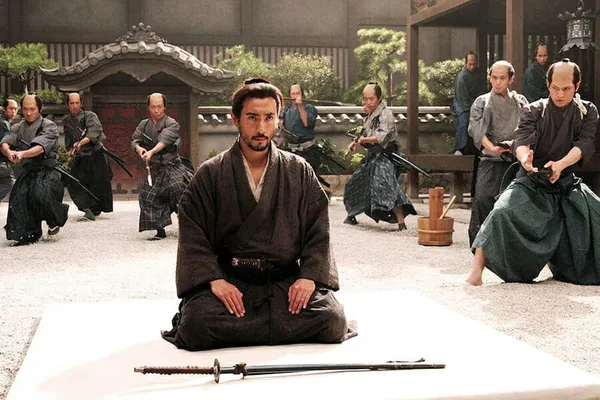Eye For Film >> Movies >> Hara-Kiri: Death Of A Samurai (2011) Film Review
Hara-Kiri: Death Of A Samurai
Reviewed by: Anton Bitel

"Another one?"
This is the grimly resigned response of Kageyu (Yakusho Koji), Chief Official of the noble Ii clan, when he is informed that there is at the gate a shabbily dressed ronin, or masterless samurai, seeking permission to commit formal seppuku (also known as harakiri, or 'cutting the belly') in the clan's forecourt. It is 1635, some three and a half decades after the Battle of Sekigahara from which the Tokugawa Shogunate had emerged triumphant; and in the peace time following this famous battle, clans that had been opposed to Tokugawa Ieyasu's forces were gradually dismantled, leading to a dramatic rise in the numbers of ronin. Many of these were driven to acts of suicidal disembowelment, both as an end to their desperate circumstances and as a restoration of their personal honour – while others merely feigned an intention to suicide as a means to employment or alms.

So, keen to avoid a potentially messy situation while still saving the face of all parties involved, Kageyu tries to deter Tsugumo Hanshiro (Ichikawa Ebizo) from his suicide mission by telling him the cautionary story of another ronin, Chijiiwa Motome (Eita), who had recently made a similar request – a request which, though insincere and venal, was 'honoured' by the Ii clan in the most cruelly barbaric and painful manner imaginable. What Kageyu does not know, however, is that Hanshiro is intimately familiar with Motome's fate, and has come armed not just with his own story to tell, but also with a desire for revenge as much as death. The Ii are about to be taught an exemplary lesson in the true meaning of honour - at the end of a cheap bamboo blade.
While making perfect sense in its context, Kageyu's question "Another one?" will also inevitably echo the thoughts of many viewers as they realise that Miike Takashi's latest feature, despite its original Japanese title Ichimei (literally 'one person'), is in fact a remake of Kobayashi Masaki's 1962 classic Seppuku (aka Harakiri), adapted from the novel by Takiguchi Yasuhiko. Indeed, although Miike's impossibly lengthy filmography has included the odd remake before (2001's The Happiness Of The Katakuris, 2002's Graveyard Of Honor), of late the retread has become a key mode of expression for this most prolific of filmmakers, whether in the cutesy kids' pic Yatterman (2009), the hyperviolent jidaigeki 13 Assassins (2010), or now in Hara-kiri: Death Of A Samurai.
The virtual perfection achieved by Kobayashi with the original Harakiri might make its reimagining a daunting, unenviable prospect for anyone, and Miike, best known as a mercurial master of kinetic excess, hardly seems a natural successor to Kobayashi's stately way with filmmaking. Contrary, however, to all expectation, Hara-kiri: Death Of A Samurai is in fact a lesson in artful restraint, slowly and deliberately building to its violent conclusion with a multi-layered narrative of flashback and counter-flashback that fleshes out (and humanises) the film's twinned scenes of self-immolation. Like Kobayashi, Miike often frames his characters in doorways that open onto other doorways, as a striking visual analogue for his film's stories-within-stories structure – but by adding 3D, Miike brings further depth to a mise-en-scène that is otherwise shot wide and with a portrait-like flatness by Kita Nobuyasu's mostly immobile camera. Anyone expecting comin'-at-ya entrails or other signs of stereoscopic sensationalism is bound to be disappointed; instead Miike's first experiment with 3D expands the enclosures of the Ii house into a resonant, multi-dimensional staging ground for complex moral drama.
If Kobayashi's film preferred heightened tension to graphic violence, Miike's version remains – perhaps surprisingly – true to this principle. Even the addition of colour in Miike's film is used to highlight less the flow of blood than the red paint of the Ii house's walls (and of the ancestral suit of armour that has pride of place in the house's centre), obliquely if vividly reflecting all the blood that has been, and will be, shed in the dubious name of honour. Meanwhile, the performances of Kabuki artist Ichikawa and his co-stars are all quietly intense, with gestures and facial expressions every bit as important as the nuanced dialogue (and this film is as much about the crossing of words as of swords). In other respects too - most notably the expanded characterisation of Hanshiro's daughter Miho (Mitsushima Hikari) and the symbolic choice of weapon employed for Hanshiro's shaming revenge - Miike has introduced subtle improvements to Kobayashi's original.
Kobayashi's period melodrama spoke to the post-war context in which it was made, as family-run corporations were emerging to dominate the Japanese economy, picking and choosing from the values of the old feudal hierarchies while excluding from employment many actual veterans of the Pacific War. As renovated by Miike for different times, now this story (obliquely) exposes the emptiness of the economic models which ruled us all before the Credit Crunch, and the lack of honour in our monetary masters who prefer to sacrifice the lives of others than to put their own houses in order. As such, this is a story that echoes down the ages, acquiring new meaning with each retelling, and relevant so long as power is dressed in complacency and hypocrisy. Perhaps further down the line there will be yet 'another one', but in the interim Miike's version of this myth is well worth the viewer's time.
Reviewed on: 30 Apr 2012


















